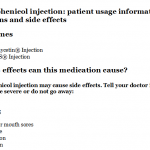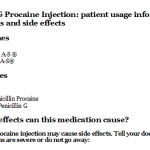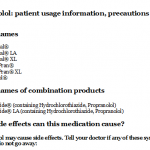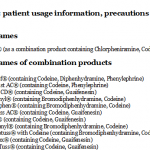
Influenza A (H1N1) 2009 Monovalent Vaccine Live, Intranasal: patient information, prescribing information, ingredients, manufacturer, adverse reactions and side effects
Sunday, April 09, 2017 by Gregory Van Dyke
http://www.naturalnewsreference.com/2017-04-09-influenza-a-h1n1-2009-monovalent-vaccine-live-intranasal-patient-information-prescribing-information-ingredients-manufacturer-adverse-reactions-and-side-effects.html
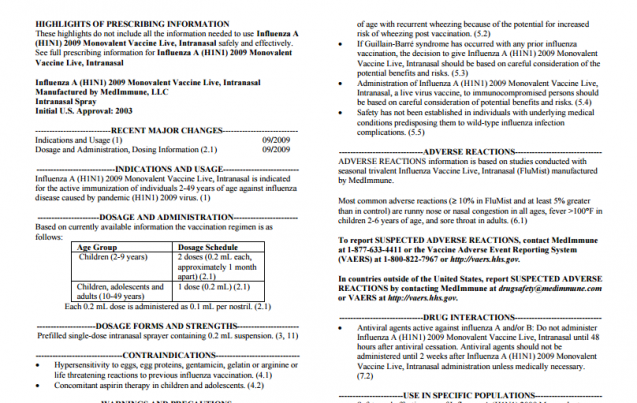
HIGHLIGHTS OF PRESCRIBING INFORMATION
These highlights do not include all the information needed to use Influenza A (H1N1) 2009 Monovalent Vaccine Live, Intranasal safely and effectively. See full prescribing information for Influenza A (H1N1) 2009 Monovalent Vaccine Live, Intranasal
See full insert sheet at this link at the Natural News Reference website.
Influenza A (H1N1) 2009 Monovalent Vaccine Live, Intranasal
Manufactured by MedImmune, LLC
Intranasal Spray
Initial U.S. Approval: 2003
INGREDIENTS AND EXCIPIENTS
Influenza A (H1N1) 2009 Monovalent Vaccine Live, Intranasal is a live monovalent vaccine for administration by intranasal spray. The influenza virus strain in Influenza A (H1N1) 2009 Monovalent Vaccine Live, Intranasal is (a) cold-adapted (ca) (i.e., it replicates efficiently at 25o C, a temperature that is restrictive for replication of many wildtype influenza viruses); (b) temperature-sensitive (ts) (i.e., it is restricted in replication at 39o C, a temperature at which many wild-type influenza viruses grow efficiently); and (c) attenuated (att) (it does not produce classic influenza-like illness in the ferret model of human influenza infection). The cumulative effect of the antigenic properties and the ca, ts, and att phenotypes is that the attenuated vaccine virus replicates in the nasopharynx to induce protective immunity.
No evidence of reversion has been observed in the recovered vaccine strains that have been tested (135 of possible 250 recovered isolates) using FluMist [see Clinical Studies (14.5)]. For the reassortant virus in Influenza A (H1N1) 2009 Monovalent Vaccine Live, Intranasal, the six internal gene segments responsible for ca, ts, and att phenotypes are derived from a master donor virus (MDV), and the two segments that encode the two surface glycoproteins, hemagglutinin (HA) and neuraminidase (NA), are derived from the corresponding antigenically relevant pandemic (H1N1) 2009 wild-type virus. Thus, the virus contained in Influenza A (H1N1) 2009 Monovalent Vaccine Live, Intranasal, maintains the replication characteristics and phenotypic properties of the MDV and expresses the HA and NA of the pandemic (H1N1) 2009 virus. For the MDV, at least five genetic loci in three different internal gene segments contribute to the ts and att phenotypes; five genetic loci in three gene segments control the ca property.
Specific pathogen-free (SPF) eggs are inoculated with the reassortant strain and incubated to allow vaccine virus replication. The allantoic fluid of these eggs is harvested, pooled and then clarified by filtration. The virus is concentrated by ultracentrifugation and diluted with stabilizing buffer to obtain the final sucrose and potassium phosphate concentrations. The viral harvests are then sterile filtered to produce monovalent bulks. Each lot is tested for ca, ts, and att phenotypes and is also tested extensively by in vitro and in vivo methods to detect adventitious agents. Monovalent bulks are diluted as required to attain the desired potency with stabilizing buffers. The bulk vaccine is then filled directly into individual sprayers for nasal administration.
Each pre-filled refrigerated Influenza A (H1N1) 2009 Monovalent Vaccine Live, Intranasal sprayer contains a single 0.2 mL dose. Each 0.2 mL dose contains 106.5-7.5 FFU of the live attenuated influenza virus reassortant of the pandemic (H1N1) 2009 virus: A/California/7/2009 (H1N1)v. Each 0.2 mL dose also contains 0.188 mg/dose monosodium glutamate, 2.00 mg/dose hydrolyzed porcine gelatin, 2.42 mg/dose arginine, 13.68 mg/dose sucrose, 2.26 mg/dose dibasic potassium phosphate, 0.96 mg/dose monobasic potassium phosphate, and <0.015 mcg/mL gentamicin sulfate. The vaccine contains no preservatives.
The tip attached to the sprayer is equipped with a nozzle that produces a fine mist that is primarily deposited in the nose and nasopharynx. Influenza A (H1N1) 2009 Monovalent Vaccine Live, Intranasal is a colorless to pale yellow liquid and is clear to slightly cloudy.
INDICATIONS AND USAGE
Influenza A (H1N1) 2009 Monovalent Vaccine Live, Intranasal is indicated for the active immunization of individuals 2-49 years of age against influenza disease caused by pandemic (H1N1) 2009 virus. (1)
DOSAGE AND ADMINISTRATION
Based on currently available information the vaccination regimen is as follows:
|
Age Group |
Dosage Schedule |
| Children (2-9 years) | 2 doses (0.2 mL each, approximately 1 month apart) (2.1) |
| Children, adolescents and adults (10-49 years) | 1 dose (0.2 mL) (2.1) |
DOSAGE FORMS AND STRENGTHS
Prefilled single-dose intranasal sprayer containing 0.2 mL suspension. (3, 11)
CONTRAINDICATIONS
Hypersensitivity to eggs, egg proteins, gentamicin, gelatin or arginine or life threatening reactions to previous influenza vaccination. (4.1)
Concomitant aspirin therapy in children and adolescents. (4.2)
WARNINGS AND PRECAUTIONS
Do not administer Influenza A (H1N1) 2009 Monovalent Vaccine Live, Intranasal to children <24 months of age because of increased risk of hospitalization and wheezing. (5.1)
Influenza A (H1N1) 2009 Monovalent Vaccine Live, Intranasal should not be administered to any individuals with asthma or children < 5 years of age with recurrent wheezing because of the potential for increased risk of wheezing post vaccination. (5.2)
If Guillain-Barré syndrome has occurred with any prior influenza vaccination, the decision to give Influenza A (H1N1) 2009 Monovalent Vaccine Live, Intranasal should be based on careful consideration of the potential benefits and risks. (5.3)
Administration of Influenza A (H1N1) 2009 Monovalent Vaccine Live, Intranasal, a live virus vaccine, to immunocompromised persons should be based on careful consideration of potential benefits and risks. (5.4)
Safety has not been established in individuals with underlying medical conditions predisposing them to wild-type influenza infection complications. (5.5)
ADVERSE REACTIONS
ADVERSE REACTIONS information is based on studies conducted with seasonal trivalent Influenza Vaccine Live, Intranasal (FluMist) manufactured by MedImmune.
Most common adverse reactions (≥ 10% in FluMist and at least 5% greater than in control) are runny nose or nasal congestion in all ages, fever >100°F in children 2-6 years of age, and sore throat in adults. (6.1)
To report SUSPECTED ADVERSE REACTIONS, contact MedImmune at 1-877-633-4411 or the Vaccine Adverse Event Reporting System (VAERS) at 1-800-822-7967 or http://vaers.hhs.gov
In countries outside of the United States, report SUSPECTED ADVERSE REACTIONS by contacting MedImmune at [email protected] or VAERS at http://vaers.hhs.gov.
DRUG INTERACTIONS
Antiviral agents active against influenza A and/or B: Do not administer Influenza A (H1N1) 2009 Monovalent Vaccine Live, Intranasal until 48 hours after antiviral cessation. Antiviral agents should not be administered until 2 weeks after Influenza A (H1N1) 2009 Monovalent Vaccine Live, Intranasal administration unless medically necessary. (7.2)
USE IN SPECIFIC POPULATIONS
MedImmune’s Influenza A (H1N1) 2009 Monovalent Vaccine Live, Intranasal and seasonal trivalent Influenza Vaccine Live, Intranasal (FluMist) are manufactured by the same process. Available information for FluMist is provided in this section.
Pregnancy
Pregnancy Category C: Animal reproduction studies have not been conducted with Influenza A (H1N1) 2009 Monovalent Vaccine Live, Intranasal or FluMist. It is not known whether Influenza A (H1N1) 2009 Monovalent Vaccine Live, Intranasal or FluMist can cause fetal harm when administered to a pregnant woman or can affect reproduction capacity. Influenza A (H1N1) 2009 Monovalent Vaccine Live, Intranasal or FluMist should be given to a pregnant woman only if clearly needed.
The effect of FluMist on embryo-fetal and pre-weaning development was evaluated in a developmental toxicity study using pregnant rats receiving the frozen formulation. Groups of animals were administered FluMist either once (during the period of organogenesis on gestation day 6) or twice (prior to gestation and during the period of organogenesis on gestation day 6), 250 microliter/rat/occasion (approximately 110-140 human dose equivalents), by intranasal instillation. No adverse effects on pregnancy, parturition, lactation, embryo-fetal or pre-weaning development were observed. There were no FluMist related fetal malformations or other evidence of teratogenesis noted in this study.
Nursing Mothers
It is not known whether Influenza A (H1N1) 2009 Monovalent Vaccine Live, Intranasal or FluMist is excreted in human milk. Therefore, as some viruses are excreted in human milk and additionally, because of the possibility of shedding of vaccine virus and the close proximity of a nursing infant and mother, caution should be exercised if Influenza A (H1N1) 2009 Monovalent Vaccine Live, Intranasal or FluMist is administered to nursing mothers.
Pediatric Use
Safety and effectiveness of FluMist has been demonstrated for children 2 years of age and older with reduction in culture-confirmed influenza rates compared to active control (injectable influenza vaccine made by Sanofi Pasteur Inc.) and placebo [see Clinical Studies (14.1)]. Influenza A (H1N1) 2009 Monovalent Vaccine Live, Intranasal is not approved for use in children <24 months of age. FluMist use in children <24 months has been associated with increased risk of hospitalization and wheezing in clinical trials [see Warnings and Precautions (5.1) and Adverse Reactions (6.1)].
Geriatric Use
Influenza A (H1N1) 2009 Monovalent Vaccine Live, Intranasal is not approved for use in individuals ≥65 years of age. Subjects with underlying high-risk medical conditions (n=200) were studied for safety. Compared to controls, FluMist recipients had a higher rate of sore throat.
Use in Individuals 50-64 Years of Age
Influenza A (H1N1) 2009 Monovalent Vaccine Live, Intranasal is not approved for use in individuals 50-64 years of age. In Study AV009, effectiveness of FluMist was not demonstrated in individuals 50-64 years of age (n=641). Solicited adverse events were similar in type and frequency to those reported in younger adults.
Safety and effectiveness of Influenza A (H1N1) 2009 Monovalent Vaccine Live, Intranasal have not been studied in pregnant women or nursing mothers. (8.1, 8.3)
Revised: xx/xxx
Recent Major Changes
Indications and Usage (1) 09/2009
Dosage and Administration, Dosing Information (2.1) 09/2009
https://www.fda.gov/downloads/BiologicsBloodVaccines/Vaccines/ApprovedProducts/UCM182406.pdf
Tagged Under: Tags: dosage, H1N1, Influenza A, ingredients, insert sheet, side effects, usage, warnings

